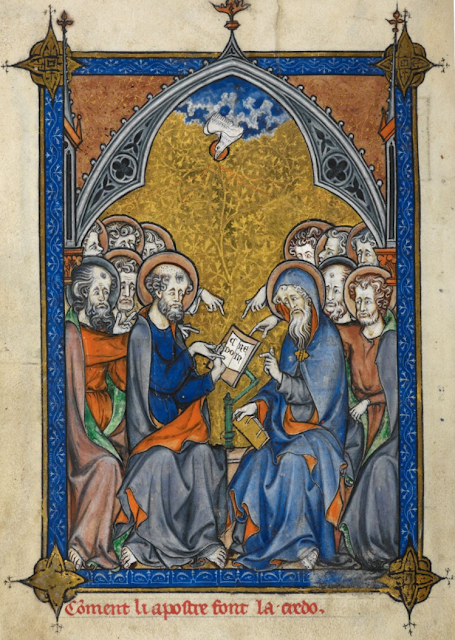Credo
Lenten Vespers, Week Two
Reading: The
Apostles’ Creed
Homily:
Grace, mercy and peace to you from God our Father and from
our Lord and Savior Jesus Christ. Amen.
Probably the first creed was some
out-of-breath soul, running up over the hillside, crying out excitedly to the
world, “He is Risen! He is Risen!”
And some bystander asked by way of
reply, “Who is Risen?”
“Jesus!” proclaimed the first fellow. “Jesus is Risen!”
“Well, who is Jesus?”
“Jesus is the Messiah!”
“What’s a Messiah?”
“Jesus!” proclaimed the first fellow. “Jesus is Risen!”
“Well, who is Jesus?”
“Jesus is the Messiah!”
“What’s a Messiah?”
And so on from there.
The word creed comes from the Latin credo, meaning “I believe,” and so a
creed is quite simply a statement of belief. The Christian Creeds—Apostles’,
Nicene, and Athanasian—expound the common teachings to which all Christians
adhere, be it implicitly or explicitly, throughout space and time. We believe
in God the Father Almighty, Creator of Heaven and earth. We believe in Jesus
Christ, His only Son, our Lord. And so on.
The oldest of these is the Apostles’
Creed. This Creed, or something very like it, was in use throughout the
Christian churches by the time of Irenaeus, only one generation removed from
the Apostles. It has defined the boundaries of orthodoxy from our earliest
days. It is in many ways a “big tent” statement. Take the First Article, for
example: I believe in God the Father Almighty, Creator of Heaven and earth.
Note that it doesn’t say anything about the specifics of Creation, only that we
all hold God to be our Creator. Plenty can be said within the broad freedoms of
interpretation. But beyond these bounds—denying God as Creator—puts us outside
the faith of the One Holy Catholic and Apostolic Church.
While the later Nicene Creed, which
builds upon the Apostles’ Creed, is a public statement of communal faith—each
article stating “we believe”—the Apostles’ Creed has for nearly 2000 years been
upheld as a baptismal creed, the profession of one seeking new life in Christ
by affirming the truth of the Gospel: “I
believe.” Baptized into Christ’s death already died for us, and into Christ’s
own eternal life already begun, we are thereby baptized into His Body the
Church. And so we, of one accord, speaking with the single voice of the Church,
together with all the saints of every age and race, are made bold to proclaim, Credo: I believe.
The structure of the Creed is
expressed in three Articles, one each for God the Father, God the Son, and God
the Holy Spirit, with the entire edifice centered firmly upon Jesus Christ.
This is no accident. The Creed is deeply, foundationally Incarnational, and it
is deeply, foundationally Trinitarian. These two always go together: we can
know God because He has become one of us in Jesus Christ; and through Jesus we
are drawn into relationship with God as Father, Son, and Holy Spirit.
God created us, and we went astray.
But He never gave up on His children. When we could not claw our way back up to
Him, God came down here into the mud and the blood, reconciling Creation to her
Creator in the person of Jesus Christ. Then Jesus poured out upon us His own
Holy Spirit, the very life and breath of God, that we might be made one in Him,
a single Body united by a single Spirit. That’s the real scandal of the
Incarnation: not just that God became Man in Jesus, but that at
Pentecost He then made all of us into Jesus: one in His Body and Blood, one in His Word
and His Spirit.
We encounter the Trinity backwards,
as it were. “I believe in the Holy Spirit, the holy catholic Church, the
Communion of saints, the forgiveness of sins, the Resurrection of the Body, and
the life everlasting.” Note that these are all the ways by which the Holy
Spirit comes to dwell within us and make us one in Christ. Thus united in Jesus,
loving the God made visible, we are drawn to love the God whom we cannot see.
And so we come to know God the Father, Son, and Holy Spirit as our own: our Creator,
Redeemer, and Sanctifier.
The eternal dance of the Trinity
consists of the Father ever pouring out His love into His beloved Son; and the
Son eternally offering all that He has, all that He is, back up to His Father.
It is perfect, infinite self-giving. And the love that flows between them, the
bond that makes them perfectly One, is the Holy Spirit Himself. By being made
one in Jesus’ Body, by being graced with the unspeakable honor of His Holy
Spirit dwelling within us, choosing our bodies as His temples, we are drawn into
the dance of the Trinity, into the very relationship of love that is God: Three
and yet One; infinite yet knowable; utterly transcendent yet unspeakably
intimate.
This is what we believe. This is our
Creed: that by the miracle of the Incarnation—God made Man in Jesus Christ—we
are drawn by grace into God’s own self, forgiven, resurrected, sanctified, deified, raised up to eternal life and
joy. It is a promise of such brobdingnagian superabundance that we could never
hope to believe it, were it not for God the Holy Spirit dwelling within us,
believing the unbelievable for us, bringing us to faith in the promise of
Christ Jesus our Lord.
This is the faith of the Church. This
is the promise we all affirm. This is the Word that brings life to the world.
Credo. I believe.
In the Name of the Father and of the
+Son and of the Holy Spirit. Amen.
- Get link
- X
- Other Apps

Comments
Post a Comment